¶ Introduction
When you intend to do a flight on the IVAO network, you will need to obtain information and authorization from people who manage the entire flight in their respective areas of responsibility. These people are air traffic controllers and they provide Air Traffic Services.
Air Traffic Services (ATS) are managed by aeronautical regulation organizations in each country. But, IVAO manages the regulation itself in the IVAO virtual world.
¶ Air Traffic Services
The aim of Air Traffic Services (ATS) is to provide pilots with one or more of the following services:
- Air Traffic Control (ATC) Services to prevent collisions and to organize traffic efficiently:
- on taxiways, runways and in the airspace around the airfield (called Control Zone or CTR), known as Aerodrome Control
service; - between arriving and departing aircraft in a Terminal Control Area (TMA) to and from one or more aerodromes, called Approach Control service;
- between en-route aircraft in Control Areas (CTA) and along Airways (AWY), this is Area Control service
- on taxiways, runways and in the airspace around the airfield (called Control Zone or CTR), known as Aerodrome Control
- Flight Information Service (FIS) by giving useful information and advice for the safe and efficient conduct of flight such as the status of navigation aids, bad weather, closed airfields etc.
- Alerting Service by assisting aircraft in difficulties and by initiating Search and Rescue (SAR).
¶ Air Traffic Control Units
Air Traffic Control Units have been designed to render air traffic control services. They are also responsible for providing flight information and alerting services to pilots.
The Air Traffic Control Unit that is typically responsible for:
- Aerodrome Control Service is called the Aerodrome Control Tower (TWR)
- Approach Control Service is called the Approach Control Unit (APP)
- Area Control Service is called the Area Control Centre (ACC) or Upper Area Control Centre (UAC)
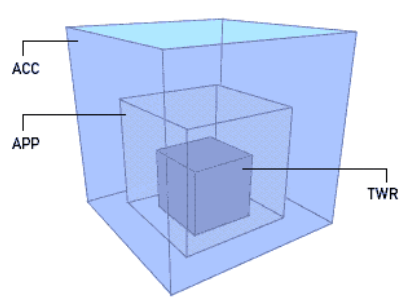
¶ Air Traffic Control Positions in IVAO
Because of the workload in airspaces and on airport grounds, the Air Traffic Control Units are operated by one person or could be sub-divided and operated by several persons. Each of these positions is assigned distinct airspace and tasks.
The Air Traffic Control positions in the IVAO network are assigned to an ICAO airfield code or ACC airspace. They are associated with a three letter suffix in function of their area of responsibility and service provided.
The only suffixes allowed in the IVAO network are:
- _DEL named delivery or clearance delivery
- _GND named ground
- _TWR named tower
- _APP named approach or arrival
- _DEP named departure
- _CTR named control, radar or centre
- _FSS named flight service station
Examples:
KJFK_GND = Kennedy Ground
LFKJ_APP = Ajaccio Approach
EGKK_TWR = Gatwick Tower
EDGG_CTR = Langen Radar
LFRR_CTR = Brest Control
EHAM_DEP = Amsterdam Departure\
When traffic is getting very dense, the Air Traffic Control (ATC) position can be split into several ATC positions as sub-positions
according to one of the 4 main compass directions, or according to a special name of sub-position defined by an official organization or charts.
¶ Clearance Delivery Position / Suffix _DEL
The Delivery position gives to IFR aircraft their initial IFR departure clearance.
The departure clearance shall include:
- Standard departure or omnidirectional departure procedure
- Take-off runway
- Initial cleared flight level
- Squawk code.
This position is only available at bigger airports in the real world. This position is part of Aerodrome Control Services.
The clearance delivery position hands off:
- Aircraft to the ground controller after IFR clearance read-back from the pilot and before push-back
Main tasks of position:
- Give IFR departure clearances prior to startup and push-back
- Give special IFR instructions in cooperation with approach controller
Main services given:
- Air Traffic Control Service: give initial IFR departure clearance
- Traffic Information Service: None (aircraft is not moving)
- Alerting Service: None. Except if the airfield is closed
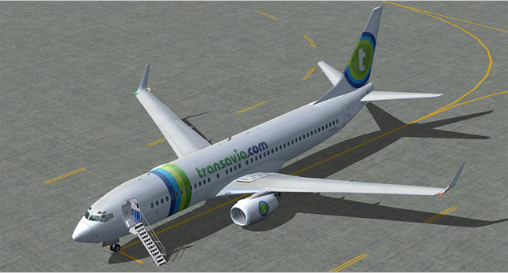
IFR aircraft on ground awaiting IFR clearance
¶ Ground Position / Suffix _GND
The Ground position handles aircraft on the ground, which includes all taxiways, all aprons but not runways.
The ground position hands off:
- Aircraft to the tower controller at the holding point of the departure runway.
The ground position receives:
- Aircraft from tower controller after vacating the runway.
- Aircraft from clearance delivery controller at the gate or apron.
Whenever an aircraft needs to enter or cross an active runway, this has to be coordinated with the tower controller first.
Main tasks of position:
- Give VFR flight plan clearances
- Give push-back clearances
- Give taxi clearance to departure runways
- Give taxi clearance to the terminal gate
Main services given:
- Air Traffic Control Service: give push-back clearance, taxi clearance
- Traffic Information Service: traffic information on ground to prevent collisions.
- Alerting Service: None. Except if the airfield is closed
In IVAO, the Ground controller takes up clearance delivery position tasks if this position does not exist or this position is not connected.
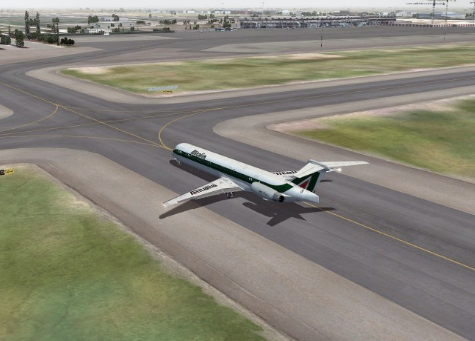
Aircraft on taxiway
¶ Tower Position / Suffix _TWR
The Tower position handles aircraft on the active runway(s) and airborne aircraft that are visual with the runway within the airspace around the aerodrome. This airspace is called the Control Zone (CTR). This includes VFR traffic and helicopters.
The tower position hands off:
- IFR aircraft to the departure or approach controller after take-off at about 1000ft AGL.
- VFR aircraft to the next approach or tower controller, auto-information area when leaving his Control Zone.
- Aircraft to the ground controller after the runway has been vacated
The tower position receives:
- Aircraft at the holding point ready for take-off from the ground controller.
- IFR aircraft established on final IFR approach from the approach controller
Main tasks of position:
- Give take-off clearances
- Give landing clearances
- Give runway crossing and back-track clearances
- Give VFR integration clearances in circuit
- Give VFR orbit clearances to delay the integration clearance
Main services given:
- Air Traffic Control Service: give landing and take-off clearances and entering runway clearances.
- Traffic Information Service: traffic information between VFR/VFR and IFR/VFR as appropriate
- Alerting Service in the control Zone.
In IVAO, the Tower controller takes up Ground position tasks if this position does not exist or this position is not connected.
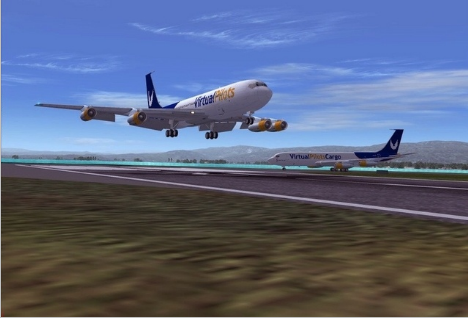
One aircraft landing and another is at holding point
¶ Approach Position / Suffix _APP
The Approach position normally handles arriving IFR aircraft near the Initial Approach Fix (IAF) towards the final IFR approach, VFR transit aircraft and airborne aircraft after they are handed off by the TWR until they can be transferred to the next ATC position. The approach responsibility airspace is called the Terminal Control Area (TMA).
The approach position can handle aircraft leaving or arriving to and from one or several airports at the same time.
The approach position hands off:
- Transit or departing aircraft to an adjacent Area Controller or nearby Approach Controller when leaving the TMA area
- Arriving aircraft to the Tower Controller after they are established on final IFR approach
The approach position receives:
- Arriving aircraft from an adjacent Area Controller to one of the airfields covered by the TMA
- Missed approach or taking-off aircraft from the Tower Controller
Main tasks of position:
- Give IFR initial, intermediate and final approach clearances
- Give radar vectoring and separates traffic using altitude, heading and speed parameters
- Make regulation clearances
- Assure adequate separation between all traffic
- Give VFR transit clearances
Main services given:
- Air Traffic Control Service: give IFR clearances and instructions including, IFR procedure, altitude, heading and speed clearances
- Traffic Information Service: traffic information between VFR/VFR and IFR/VFR as appropriate
- Alerting Service in the Terminal Area
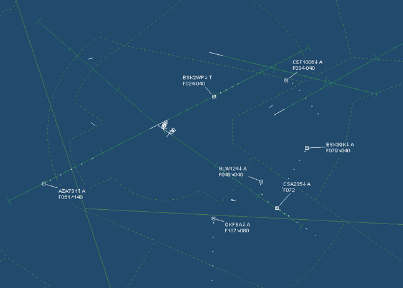
ATC approach radar with 6 aircraft displayed and 3 airfields
In IVAO, the Approach controller takes up Tower position tasks if this position does not exist or this position is not connected. In IVAO, the Approach controller takes up Departure position tasks if this position does not exist or this position is not connected.
At some airports, the different tasks of the approach position are split between several positions:
- Initial, Intermediate and/or Final approach positions
- Northern and southern or western and eastern approach positions
- Departure or arrival positions
Real approach airspaces are sometimes very complex and can be any combination of previously mentioned positions above.
These different positions can use an intermediate suffix :
XXXX_INI_APP, XXXX_ITM_APP, XXXX_FIN_APP
XXXX_W_APP, XXXX_E_APP, XXXX_N_APP, XXXX_S_APP
XXXX_DEP, XXXX_APP\
¶ Departure Position / Suffix _DEP
The Departure position normally handles departing aircraft after they are airborne and handed off by the TWR until they can be transferred to the next ATC position. The departure responsibility airspace is called the Terminal Control Area (TMA).
The departure position should only be opened with the approach position at the same time and with a tower position opened.
The departure position hands off:
- Departing aircraft to an adjacent Area Controller or nearby Approach Controller when leaving the TMA area
The departure position receives:
- Missed approach or taking-off aircraft from the Tower Controller
Main tasks of position:
- Give IFR clearances
- Give radar vectoring using altitude, heading and speed parameters
- Make departure regulation clearances
- Assure adequate separation between all traffic
Main services given:
- Air Traffic Control Service: give IFR clearances and instructions including IFR procedure, altitude, heading and speed clearances
- Traffic Information Service: traffic information between VFR/VFR and IFR/VFR as appropriate
- Alerting Service in the Terminal Area
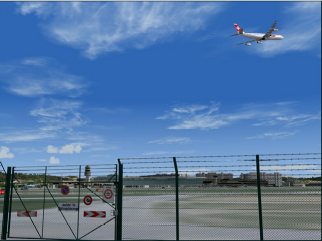
One departing aircraft climbing
¶ Area Control Position / Suffix _CTR
The Area Control position (also named ACC) normally handles the aircraft while flying en route or climbing or descending from or into an airfield situated in its Flight Information Region (FIR). A FIR is a wide area of airspace in which Countries are responsible for the provision of the Air Traffic Services (ATS).
If there is an Upper Area Control (UAC) sector active above the normal ACC (CTR), its tasks are basically the same as for the ACC (CTR), but in the Upper Airspace. Usually, in IVAO, ACC takes care of the UAC position.
The ACC or UAC airspaces are mainly above TMA airspaces and control all IFR traffic en-route.
The ACC position hands off:
- En-route traffic to the nearby ACC controller or UAC controller
- Inbound traffic to the Approach controller
The ACC position receives: En-route traffic from the nearby ACC controller or UAC controller Outbound traffic from the Approach / Departure controller
Main tasks of position:
- Give STAR/arrival route clearances
- Give directs and regulation clearances
- Give radar vectoring using altitude, heading and speed parameters
- Assure adequate separation between all traffic
Main services given:
- Air Traffic Control Service: give en-route clearances, give IFR clearance and instructions including altitude, heading, speed
clearances and STAR/arrival clearances - Traffic Information Service: traffic information between VFR/VFR and IFR/VFR as appropriate
- Traffic Information Service: traffic information between VFR/IFR and IFR/IFR
- Alerting Service in the FIR Area
In IVAO, the ACC controller can take up approach position tasks if these positions are not connected. The ACC controller shall limit himself
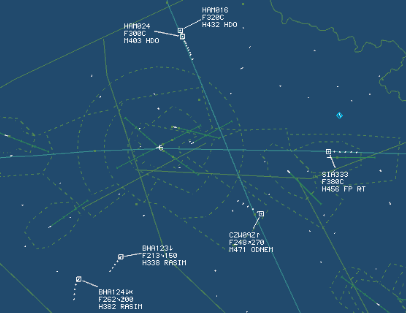
ATC ACC Radar showing en-route aircraft
¶ Flight Station Services Position / Suffix _FSS
The Flight Service Station position provides Flight Information Service, search and rescue services, aircraft assistance, advises about Notices to Airmen (NOTAMs), weather conditions and Oceanic Control.
The Flight Station position hands off:
- Any traffic that will enter into controlled airspace
- En route Traffic to the nearby FSS position
The Flight Station position receives:
- En-route traffic from the nearby ACC controller or UAC controller
- Departing traffic from the Approach or Departure controller
The Flight Service Station Position does neither provide any Air Traffic control nor radar services. This position cannot give radar vectoring, climbing/descending and speed clearances or instructions, and also cannot separate traffic with clearances or instructions.
Main tasks of position:
- en route traffic information
- search and rescue services
- assists lost aircraft
- assists aircraft in emergency
- relays ATC clearances
- advises about Notices to Airmen (NOTAMs)
- broadcasts aviation weather information
- informs about the status of NAVAID's
- traffic information to VFR and IFR traffic
Main services given:
- No Air Traffic Control Service given
- Traffic Information Service: traffic information between all traffic known to him.
- Alerting Service in the FSS Area
¶ Observer, Training and Staff Position:
In IVAO, you can see some other connections like:
- XXXX_T_YYY: The T says that the position is a trainer session connected at XXXX airport and YYY position.
- XXXX_X_YYY: The X says that the position is an examination session connected at XXXX airport and YYY position.
- XXXX_EXA_YYY: The EXA says that the position is an examination session connected at XXXX airport and YYY position.
- XXXX_YYY_OBS: The _OBS says that the position is an observer person.
Note that all of these call signs are not active positions. As a pilot you cannot connect to their frequency and be controlled by them. You can only chat with them by private messages.
In IVAO, you can see some staff connections:
- XXXX-CH XXXX-ACH XXXX-CHA1: The --CH and --ACH are FIR chiefs and their assistant. They are staff members. (Example EGTT-CH, KZNY-ACH).
- XXXX-ST1 XXXX-STA2 : The service team of XXXX FIR. They are working together with FIR chiefs inside a FIR. (Example : EDGG).
- DD-XXX: This type of call sign is reserved for division staff members. DD is the two letters that represent their division.
(Example DE-FOC, BR-AOC, ZA-TC, GB-DIR) - IVAO-XXX: This type of call sign is reserved for international HQ staff members. XXX represent their function in the IVAO network. (Example IVAO-TD, IVAO-EXEC1, IVAO-FOD, IVAO-TDM).
Note: During training or examination sessions, procedures may be interrupted by the trainer or examiner. Take this into account when visiting such airports. Although IVAO encourages pilots to visit these airfields to provide them with sufficient traffic, you may expect some training limitations. The trainer or examiner may give specific instructions or have particular requests, such as staying outside the airspace or on the ground for a while when needed for training.
- none
- VID 150259 - Creation
- VID 150259 - Wiki integration
- VID 496402 - Wiki.js integration